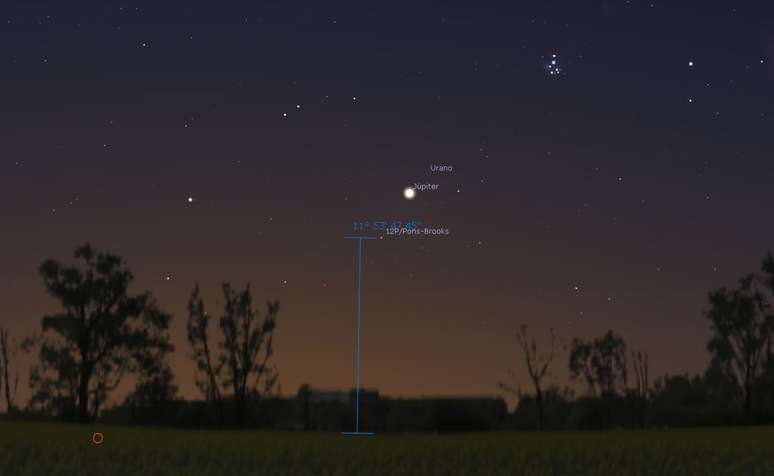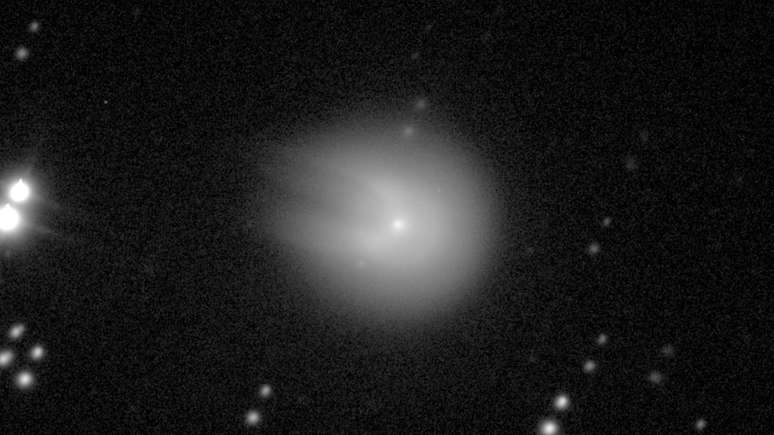The “Devil’s Comet” could become visible to the naked eye over the next few weeks; knowing how to observe
One of the most curious comets is approaching our planet, 71 years after its last visit, and it could become visible to the naked eye. We are talking about 12P/Pons-Brooks, nicknamed the “Devil’s Comet” for the shape it sometimes presents. Find out everything you need to know to watch it below.
- March sky | Conjunctions, equinoxes and comets are the highlight of this month
- Who defines the names of comets? How is the choice made?
What is the devil’s comet?
Comet 12P/Pons-Brooks became famous when its distinctive shape was compared to the Millennium Falcon spacecraft. Star Wars. Others compare the shape to horns, which is why it was given the “official” nickname Devil’s Comet.
But why does it take this form? Well, it’s not often that the Pons-Brooks look like the “captain”, but only when their cryovolcanoes explode. As it approaches the Sun, gases within the 30km-diameter core heat up and are ejected as cryomagma. Even some explosions it can turn green.
Comet 12P/Pons-Brooks about a week after the explosion.
07/27/2023 T 19:02 UTC
L: 3 x 180 inch CDK500/C3-61000
Skygems, Spain. pic.twitter.com/gV43iKP86U
— MMC Astro (@MMCAstronomy) July 28, 2023
Comets of this type form in the most distant regions of the Solar System, where temperatures are extremely low. Astronomers are very interested in these objects because when cryovolcanoes erupt, the ejected materials may be “pure”, that is, completely unchanged since the formation of the Solar System.
Orbit of comet Pons-Brooks
Astronomers have known about Comet Pons-Brooks since 1812, and its orbit is already well known. It is a periodic object, that is, it passes through the Solar System to complete a revolution around the Sun in specific periods, in a cyclical manner.
In April, the comet will reach perihelion (the point in its orbit where it comes closest to the Sun before moving away again), becoming closer to our star than to Earth. However, it will be even further from the Sun than the planet Venus.
Will Pons-Brooks be visible in Brazil?
Even before the perihelion, which will take place on April 21, astronomers and enthusiasts will be able to look for the comet and try to observe it with the naked eye. However, this time of year favors inhabitants of the Northern Hemisphere, with little chance of good observations in the Southern Hemisphere.
In addition to the Sun, another “bad” that observers will have to deal with is the position of the comet in the sky: when the Sun sets, Pons-Brooks will be very close to the horizon, making observation practically impossible in the southernmost regions of the planet. Village.

On the other hand, northern and northeastern regions may have better luck, finding the comet noticeably higher above the horizon after sunset. It will still be in an unfavorable position for correct observation, but the unpredictability of comets in terms of brightness can surprise.
During May and June it may be easier to find the comet in the Northern Hemisphere, as it will be a little further away from the Sun. It will still be very close to the horizon, but the sky will be a little darker for longer before sunsets.
How to observe the comet
Just after sunset, when twilight still turns the sky orange, there is a small chance of finding the comet if it is bright enough. If you have binoculars suitable for astronomy (with an aperture of at least 50 mm), you may have a better chance of seeing it.
Regardless of the date and location of the observer, Pons-Brooks will always be on the same side of the sunset, so that’s where we should look. Warning: do not look at the sky when the Sun is still above the horizon, even if it is about to set. This can permanently damage your vision.
During the month of March the comet will be to the right of the star, while in April it will be just above the solar disk, being completely obscured. After the perihelion on April 21, we will be in the best time to observe it in the Southern Hemisphere.
Comet 12P/Pons-Brooks was truly magnificent last night in a clear, dark sky! Eat now greatly enlarged with a highly condensed bright nuclear region. pic.twitter.com/VvDFnECq1I
— David Strange (@dgs99) October 15, 2023
As May approaches, the comet will move to the left again, away from the brightest area of twilight. The position relative to the horizon will remain the same, but the sky will be relatively darker. In return, the comet’s apparent brightness will also decrease.
It won’t be an easy task to observe 12P/Pons-Brooks, but the Southern Hemisphere may have a better chance in June, according to NewScience. When it comes to comets we may have some hope of being surprised, but nothing is guaranteed.
Source: Space.com, NewScientist
Trends on Canaltech:
- IRPF Schedule 2024 is now available; see how to download
- 🔥 MORE DOWNLOADED | Buy Galaxy Watch 5 Pro on super offer
- The tragedy of the life of Jake Lloyd, the actor who played the young Anakin
- The 10 best racing games for Android
- Grant Morrison has the perfect answer to Zack Snyder’s Batman
- The 45 most anticipated films of 2024
Source: Terra
Rose James is a Gossipify movie and series reviewer known for her in-depth analysis and unique perspective on the latest releases. With a background in film studies, she provides engaging and informative reviews, and keeps readers up to date with industry trends and emerging talents.






